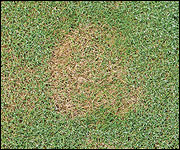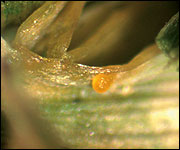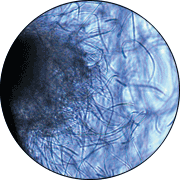Copper spot
Symptoms and signs | Conditions | Management
Copper spot is a foliar disease of bentgrass, with severest outbreaks occurring on velvet bentgrass. It also occurs sporadically on creeping bentgrass greens and higher cut creeping bentgrass tees and fairways. Gloeocercospora sorghi causes a leaf spot of bermudagrass and zoysiagrass as well.
Pathogen
- Gloeocercospora sorghi
Hosts
- Bentgrass
- Bermudagrass
- Zoysiagrass
Symptoms can be confused with those of
- Anthracnose basal rot
- Brown patch
- Dollar spot
- Pythium foliar blight
- Red leaf spot
Symptoms and signs
Although Gloeocercospora sorghi initially causes a leaf spot on creeping bentgrass, this phase of the disease is rarely observed in the field, because infected leaves are rapidly blighted. Usually the first indication of disease is the appearance of pinkish orange to copper-colored patches with irregular margins (Figure 1). The patches range from 1 to 3 inches in diameter, but under favorable conditions for disease development, patches often coalesce. Symptoms can also occur in streaks, because the fungus is easily spread by water and equipment.
The color of the patches is more pronounced under moist conditions that favor production of sporodochia (fruiting bodies). The conidia (spores) are produced on the sporodochia in gelatinous masses that can be observed with a hand lens. Look for pink to salmon-colored gelatinous spore masses protruding from leaf surfaces (Figure 2). The long, needle-like conidia within a spore mass are multicelled and usually curved (Figure 3).
Symptoms are easily confused with those of anthracnose basal rot, brown patch, dollar spot, Pythium blight or red leaf spot. Dollar spot occurs under slightly cooler temperatures and the infection sites tend to be tan rather than pink. Temperatures favorable for optimum development of Pythium foliar blight and red leaf spot coincide with those of copper spot. Red leaf spot patches on a putting green are less defined than those of copper spot. Initial infection sites of Pythium foliar blight also have a similar color to those of copper spot, but Pythium foliar blight develops under higher temperatures and is rare on greens-height bentgrass. Copper spot infection sites are generally more discrete than those of anthracnose basal rot, which are more diffuse.
Conditions
The disease is reported to be more common and severe on velvet bentgrass than on creeping bentgrass. It is also more severe under acidic soil contions. This may account for the sporadic nature of the disease, because the soil pH of many putting greens is high.
G. sorghi produces huge quantities of conidia in warm, moist weather (68 to 86 degrees F). Disease severity increases with prolonged periods of leaf wetness. Under these favorable conditions, the pathogen is readily spread if the turfgrass is mowed when the leaves are wet. The pathogen is also easily spread by splashing water (rainfall or irrigation) and through surface runoff. Spread also occurs in relation to the activities of people and animals.
Excess available nitrogen enhances disease development.
Management
The common fungicide spray programs that are used in creeping bentgrass systems generally suppress copper spot. Refer to Table 5 for a list of fungicides labeled for control of copper spot. If a disease outbreak occurs, remove early morning dew and plant exudates (guttation water) with several turns of the irrigation head. Avoid mowing when the leaves are wet. Also avoid the use of water-soluble nitrogen when copper spot is active.


